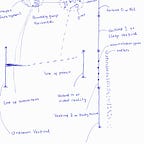Neuroscience: Can an Artificial Thalamus Solve Death?
What is the mechanism of cardiopulmonary resuscitation that makes it effective? How exactly does cardiac defibrillation work?
There are explanations along the heart, including for blood flow to the brain but when anything — as a sensory input — touches the body, what does the brain do about it?
If someone has pain somewhere and applies a cold compress, there could be relieve in that area, but receptors sent signals from that spot, first — to the brain before it got back, albeit happening so fast.
So defibrillation and resuscitation have something to do with the sense of touch, which became what went to the brain to, in part, assist with recovery from ventricular fibrillation.
Sensory inputs in the brain mostly land in the thalamus, where they are processed, before relay to the cerebral cortex for interpretation.
Smell lands at the olfactory bulb, for processing before relays, to the orbitofrontal cortex, piriform cortex and others.
It is the process of interpretation that becomes affect in other areas of the body.
This means that as [versions of] sensations reaches the cerebral cortex, they build responses that determine what is perceived as relieve.
The cortex — directing coordination for experiences — hosts what it means to know that something is different.
Hence, different senses from different parts of the body have representations in the cortex, allowing perceptual alternations across.
Although defibrillation and resuscitation stimulate the heart, the cerebral cortex and the thalamus play a role.
In a recent breakthrough study, “Cellular recovery after prolonged warm ischaemia of the whole body” published in Nature, the researchers described using a new technology [OrganEx modified from BrainEx] to deliver a specially designed cell-protective fluid to organs and tissues, restoring blood circulation and other cellular functions in pigs a full hour after their deaths.
It was reported that, “Six hours after treatment with OrganEx, certain key cellular functions were active in many areas of the pigs’ bodies — including in the heart, liver, and kidneys — and that some organ function had been restored. For instance, they found evidence of electrical activity in the heart, which retained the ability to contract.”
Though they reported that they found that “cellular activity in some areas of the brain had been restored, they said no organized electrical activity to indicate consciousness was detected during any part of the experiment”.
It expressed that cells were revitalized in the brain and other organs, but consciousness [or overall control] was absent.
The study was also similar to another, published in Nature, “Revival of light signalling in the postmortem mouse and human retina” where electrical activity was restored in human retinas after death.
These advances hold promise for localized organs, but what is the possibility to keep on consciousness, to prevent death?
Consciousness is described as what it means to be and to know, which can be described as a — uniform — quantity [to be] and the memory [to know].
This [uniform] quantity is postulated to emerge from sensory processing in the thalamus and olfactory bulb.
It is this [uniform] quantity that goes on to for interpretation.
Interpretation is hypothesized to be knowing, feeling and reaction.
Knowing is memory.
So consciousness can be said to be mostly thalamic and cerebral cortex roles.
It is what gets loaded in, from the thalamus that becomes what the cerebral cortex can use, even when there are — little to — no external stimuli during sleep, though internal stimuli [or interoception] still reports through the thalamus, like during coma and in general anesthesia.
Since the thalamus is an egg-shaped mass of the diencephalon, if there is an artificial or a neurotech device, in its place, to receive and send signals, it may continuously drive the cortex to action, keeping some functions alive, since everything controlled by brain is in equivalents — of senses and signals — going back and forth.
This means that if the brain can have an internal connector doing the work of the thalamus, just like external devices — the ventilator, hemodialysis, feeding tube, urinary catheter and so on — take on bio roles, there might be possibility to shove aging and solve death.
Though brain-computer interfaces are still based in cortical areas, the thalamus is subcortical, with lots of blood and difficulty to influence, there could be possibility in the future to solve death from an artificial thalamus.
